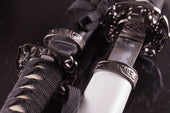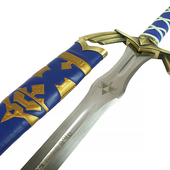Katanas are more than just weapons—they are symbols of craftsmanship, tradition, and cultural legacy. Whether you own one as a collector, martial artist, or enthusiast, preserving its integrity through proper maintenance is key to ensuring it lasts for generations. Yet many katana owners unknowingly make simple maintenance mistakes that can cause irreversible damage.
Avoid damaging your katana with these five common maintenance mistakes. Learn how to properly clean, store, and handle your sword to prevent rust, dulling, and wear. This quick guide covers everything you need to know to keep your blade sharp, polished, and protected for years to come.
The Legacy of the Samurai and Their Blades
To truly understand the importance of katana care, one must look to the warriors who carried them—the samurai. As members of Japan’s noble military class, the samurai were bound by bushidō, the “way of the warrior,” which emphasised honour, discipline, and respect. Their katana was more than a weapon—it was an extension of their soul and a symbol of their status and values.
Samurai were known to maintain their swords with meticulous care, understanding that a neglected blade could mean defeat or dishonour. Every part of the katana, from the razor-sharp edge to the ornate fittings, was crafted with precision and worthy of reverence. Regular cleaning, respectful handling, and proper storage were considered essential duties.
Today, katana owners continue that legacy. Whether you display your sword, use it for martial arts, or collect it for its beauty, maintaining it properly is a mark of respect not only for the blade, but for the centuries of tradition it represents.
Using the Wrong Cleaning Tools
Mistake: Using household oils, abrasive cloths, or harsh cleaning chemicals.
Why It’s a Problem: A katana's blade is typically made from high-carbon steel, which is both strong and vulnerable to corrosion if not properly cared for. Using the wrong products can scratch the blade, ruin its polished surface, or leave behind residues that promote rust.
How to Avoid It:
-
Use a traditional katana cleaning kit which usually includes choji oil (clove-scented mineral oil), an uchiko ball (containing fine polishing powder), and a soft rice paper or microfibre cloth.
-
Gently tap the uchiko ball to dust the blade with powder, then wipe with a clean cloth in one direction.
-
Apply a small amount of oil evenly to protect the blade from moisture.
Top Tip: Avoid WD-40, machine oil, or glass cleaners—these can do more harm than good.
Neglecting Regular Maintenance
Mistake: Only cleaning the blade when it appears dirty.
Why It’s a Problem: Just because your katana looks clean doesn’t mean it’s free of damaging particles. Even minimal exposure to air, fingerprints, and humidity can lead to oxidation and rust. Inconsistent maintenance allows small issues to build up unnoticed.
How to Avoid It:
-
Inspect your katana every few weeks, especially if it’s handled often or displayed in an open environment.
-
Reapply a thin coat of protective oil after every cleaning.
-
If the katana is used in practice, increase the frequency of maintenance.
Pro Tip: Create a routine maintenance calendar—monthly for display pieces, fortnightly for handled or used blades.
Touching the Blade with Bare Hands
Mistake: Handling the blade directly with your fingers.
Why It’s a Problem: Human skin secretes oils, salts, and moisture that quickly oxidise metal. Fingerprints can turn into rust spots in a matter of days, especially in humid conditions.
How to Avoid It:
-
Always handle the blade by the tsuka (handle), not the sharp edge.
-
Wear cotton gloves or use a cloth to grip the blade if you must touch it.
-
If you accidentally touch the blade, clean and re-oil it immediately.
Improper Storage Conditions
Mistake: Storing the katana in its saya (scabbard) for long periods, or in a damp room.
Why It’s a Problem: While the saya is designed to protect the blade, it can trap moisture if the katana isn’t oiled correctly or if the room has high humidity. This creates a perfect environment for rust to form, often without visible warning signs.
How to Avoid It:
-
Store your katana in a dry, cool, and well-ventilated area.
-
Use a sword rack or horizontal stand to allow air circulation.
-
Remove the katana from its saya periodically to inspect and re-oil the blade.
Extra Tip: Consider using silica gel packets near your display or storage area to absorb excess moisture.
Over-Sharpening or DIY Polishing
Mistake: Attempting to sharpen or polish your katana without proper training.
Why It’s a Problem: Katana polishing is an intricate process that not only sharpens the edge but also refines the geometry and enhances the hamon (temper line). Improper DIY attempts can cause uneven edges, weaken the blade, or destroy the original finish.
How to Avoid It:
-
Leave sharpening and polishing to a professional togishi (traditional sword polisher).
-
If you notice minor dulling, focus on protective maintenance rather than aggressive sharpening.
-
Never use household whetstones or electric sharpeners.
Cleaning Katana Sets vs Individual Katanas
Caring for a katana set—typically consisting of a katana, wakizashi, and tanto—requires a bit more attention than maintaining a single sword. While the cleaning process remains largely the same, each blade should be treated individually using fresh materials where possible to avoid cross-contamination of oils or residues.
-
Clean One at a Time: Lay out each sword separately and follow the standard maintenance steps—uchiko powder application, gentle wiping, and oiling—on each blade individually.
-
Use Separate Cloths if Possible: Especially for high-end sets, consider using different cloths or cleaning tools per blade to preserve their unique finishes.
-
Check Saya and Fittings: Sets often come with decorative matching scabbards and fittings. Wipe these with a dry, soft cloth to remove dust, and avoid moisture or polishing oils unless specifically designed for decorative surfaces.
Regular and careful maintenance of your katana set not only preserves the appearance of each piece but also upholds the harmony and craftsmanship that defines a matched collection.
Bonus Tips for Katana Longevity
Taking care of your katana goes beyond just regular cleaning. The way you store, transport, and display your sword can significantly impact its lifespan. Here are some bonus tips to help you extend the longevity of your prized blade:
-
Transport Properly: Always use a padded sword bag or a protective hard case when transporting your katana. This helps prevent unnecessary movement, scratches, and exposure to the elements. Avoid storing the katana in the boot of a car for extended periods, especially in fluctuating temperatures.
-
Display Safely: While displaying your katana on a stand is visually impressive, be mindful of where you place it. Avoid locations near heat sources such as radiators, fireplaces, or direct sunlight through windows, as these can dry out the handle wrap (tsuka-ito) and potentially warp the blade over time.
-
Monitor the Environment: Humidity is a katana's silent enemy. If you live in a humid climate, consider using a dehumidifier or placing silica gel packs nearby. These steps will help prevent rust and maintain the blade's pristine finish.
-
Keep the Saya Clean: The inside of the saya should be kept dry and free of debris. Dust, dirt, or moisture inside the scabbard can lead to fine scratches or tarnish when the blade is repeatedly sheathed. Occasionally inspect and gently clean the interior using proper tools if needed.
-
Avoid Overhandling: Even outside of formal maintenance, try to limit casual handling. The less the blade is exposed to skin oils and environmental moisture, the better it will preserve its condition.
By following these practical tips, you’ll not only maintain the sharpness and aesthetics of your katana but also ensure its value and legacy endure.
Honour Your Blade: Keep Your Katana in Pristine Condition
A katana isn’t just a blade; it’s a piece of art, history, and identity. By avoiding these common maintenance mistakes, you can ensure your sword remains in excellent condition for years to come. Remember, care and respect go hand-in-hand when it comes to owning such a revered item.
At The Sword Stall, we provide more than just swords—we offer everything you need to keep them in peak condition. From traditional cleaning kits to educational guides, we help enthusiasts preserve the beauty and legacy of their blades.
Explore our full range of katana care products today and honour your blade the way it deserves.



















































